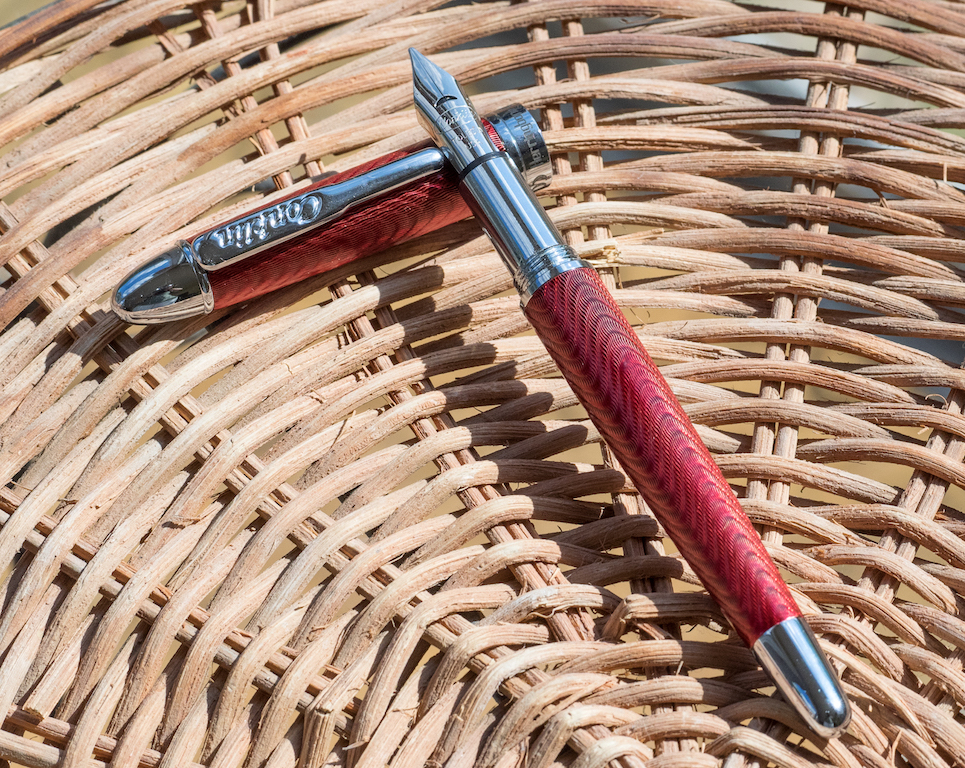(Susan M. Pigott is a fountain pen collector, pen and paperholic, photographer, and professor. You can find more from Susan on her blog Scribalishess.)
The Conklin Herringbone is a metal fountain pen etched with the herringbone pattern, then coated with lacquer and epoxy for a shiny finish. The herringbone pattern gives the pen a nice tactile feel, plus it is absolutely gorgeous in sunlight. Although this pen is called “burgundy red” it’s really more of a cherry red, in my opinion. Regardless of what you call the color, it’s quite striking.
The pen comes packaged in a blue clamshell box with a soft, cream interior.
Stainless steel, conical finials adorn the cap and the bottom of the pen’s barrel. Because it is made of metal, it’s a fairly heavy pen for its size, weighing 42 grams. It is 146mm capped, 125mm uncapped, and 160mm posted.
The screw-on cap comes with a solid clip engraved with the Conklin name. This clip will hold the pen firmly to a shirt pocket or a tablet.
The cap is also adorned with a stainless steel ring engraved with the word “Herringbone” and crescents on either side.
The Conklin Herringbone is a cartridge/converter fountain pen, and the converter holds about 1ml of ink.
This pen came with a 1.1mm stainless steel stub nib. It has Conklin’s signature crescent-shaped breather hole and is engraved with the Conklin name, Toledo, USA, and the nib size.
Unfortunately (for me, at least), the grip is also stainless steel. I’ve discovered I’m not a fan of metal grips because they can become slippery if you have sweaty fingers (which I often do). The grip on the Conklin Herringbone is also pretty slim (9.1mm). I prefer wider grips because they prevent hand cramping, which is becoming more of a problem for me as I get older.
Aside from being a bit too narrow, the pen is comfortable in the hand. I’ve been using it at school for the last two weeks inked with Robert Oster Astorquiza Rot, and it has performed well in my Hobonichi notebook. I also tested it on a page of Baron Fig Mastermind paper which I keep at my desk to write notes. I spent some time writing out the alphabet and a quote from the current Harry Potter book my First Year Seminar is reading.
The pen writes well—I didn’t experience any hard starts or blobs while writing. However, I did notice that sometimes the pen skipped a little bit on the downstrokes of letters like “l” and “f.”
The Conklin Herringbone retails for $70.00, but you can purchase it on sale from Goldspot Pens for $55.95. It comes in burgundy red, gun metal gray, and navy blue, and you have a choice of fine, medium, and 1.1mm stub nibs.
Pros
- I really like the look of the Conklin Herringbone. The pattern is eye-catching, and the lacquer and epoxy make it shine.
- The pen is a reasonable size for most writers, though some may find it a little heavy since it’s made of metal. Others, like me, will find the grip to be too narrow for comfort.
- The 1.1mm stub nib wrote well. On Tomoe River paper (in my Hobonichi) the nib produced a generously wet line. On the Baron Fig paper, the ink soaked in a bit more and the nib seemed less wet. Regardless, I found it wrote pretty consistently aside from a few skips on downstrokes.
- This pen is reasonably priced, especially on sale.
Cons
- Although I like hefty pens, I don’t care for thin, hefty pens. The Conklin Herringbone is too thin for my aging hands. I need a wider grip to write for long periods without hand cramps.
- If you struggle using pens with metal grips, like I do, then you probably will not like this pen.
- As stated above, the nib performed well, but skipped occasionally on downstrokes.
(Goldspot Pens loaned Pen Addict this Conklin Herringbone fountain pen for review purposes.)
















